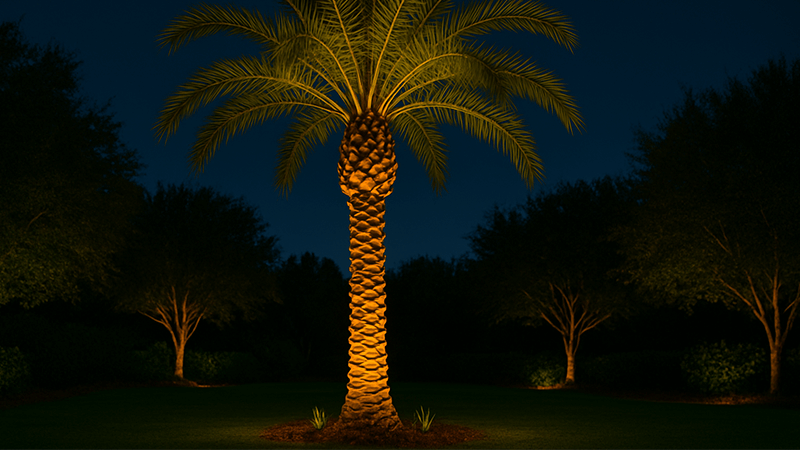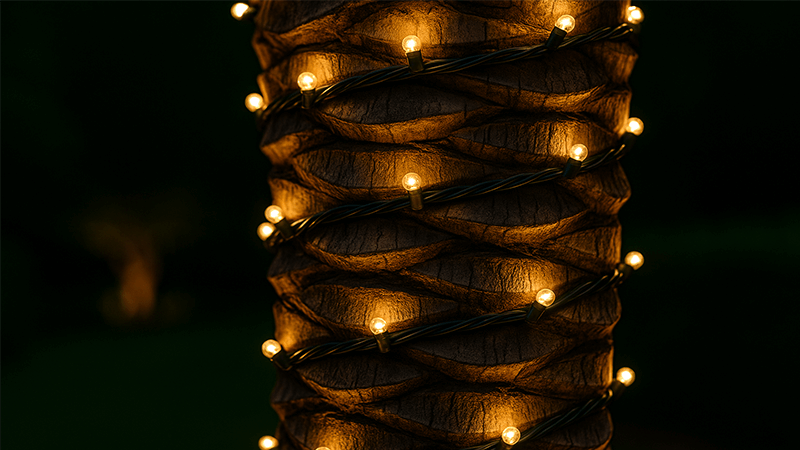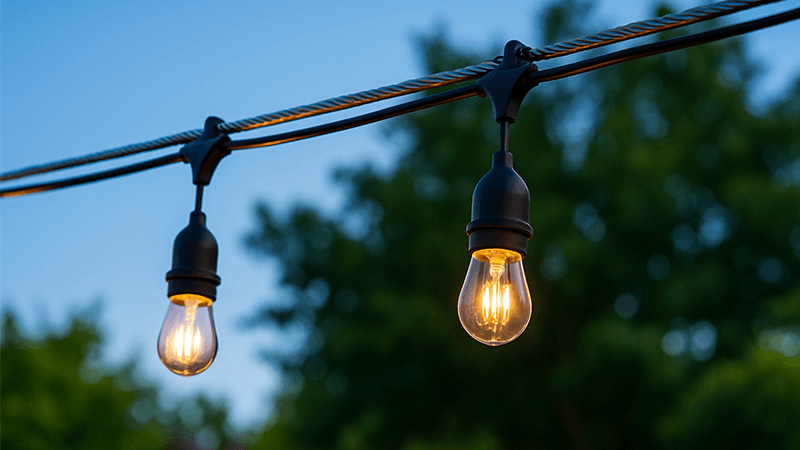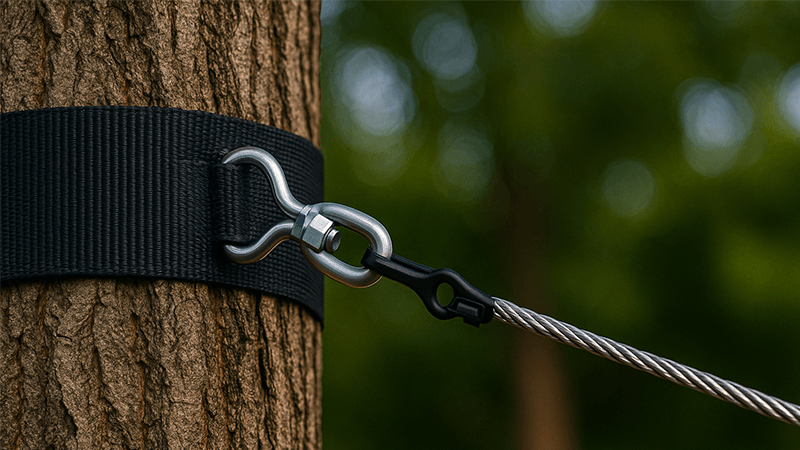Your palm trees look great during the day but disappear at night. Bad lighting can harm them. I’ll guide you to illuminate them safely and beautifully.
The best method is using outdoor-rated lights. You can wrap the trunk with string lights, starting from the base. Or, place uplights at the bottom to illuminate the fronds. Always prioritize the tree’s health and safety.

Choosing the right method is just the first step. The real magic is in the details, from picking the perfect lights to ensuring a safe and lasting installation. I’ve spent years helping clients like Shaz in the UAE perfect these projects. Let’s break down each step so you can get the same professional results.
How do I put lights on my palm tree?
Ready to install your palm tree lights but worried about damaging the tree? A tight wrap can hurt its growth. Let’s cover the best techniques I recommend.
Wrap string lights loosely around the trunk, allowing slack for growth. Use plastic zip ties or plant-safe clips, not staples. For uplighting, place two or three fixtures at the base, aiming them up towards the canopy for dramatic effect.

There are two primary methods I suggest to my partners for lighting palm trees: wrapping the trunk and uplighting. The choice depends on the look you want to achieve. Both are effective, but the execution is critical for both the tree’s health and the light’s performance.
Method 1: Wrapping with String Lights
This is the classic, festive look. It’s perfect for creating a warm, inviting atmosphere. But doing it right is key. You must never use staples, nails, or anything that pierces the trunk. A palm tree’s trunk doesn’t heal like other trees, and piercing it can create entry points for disease. I always advise using UV-resistant plastic zip ties or specialized tree-safe clips. When you wrap the string lights, leave enough slack. A good rule of thumb is to be able to fit your hand between the lights and the trunk. This gives the tree room to grow without being girdled by the wires. Start at the base and work your way up. Plan your spacing beforehand to ensure a clean, even spiral. This attention to detail is what separates a professional job from an amateur one.
Method 2: Uplighting with Spotlights
For a more dramatic, architectural effect, uplighting is the way to go. This technique highlights the unique texture of the trunk and the beautiful shape of the fronds. The key here is placement and beam angle. I recommend using two to three outdoor-rated LED spotlights per tree. Place them in the soil or mulch about one to two feet away from the base. Aim them up at the canopy. A narrow beam angle (15-30 degrees) will create a focused, dramatic shaft of light up the trunk. A wider beam angle (40-60 degrees) will illuminate more of the fronds, creating a softer, broader glow. In my factory, we produce spotlights with various beam angles specifically for these applications, as our clients often need to create different moods for different landscape projects.
Are grow lights good for palm trees?
Your outdoor palms seem to be struggling, and you wonder if a grow light could help. But using the wrong type can do more harm than good.
Traditional grow lights are designed for indoor plants and are not suitable for outdoor use. They are not weatherproof and lack the intensity for mature outdoor palms. Instead, focus on providing proper sunlight, water, and soil nutrients for outdoor tree health.

This is a question I get surprisingly often, especially from clients in regions with varied climates. People see their indoor plants thrive under grow lights and think the same logic applies outdoors. It’s a common misunderstanding. Grow lights are a specific tool for a specific job, and that job is typically indoors.
Understanding Grow Light Function
Grow lights work by emitting specific wavelengths of light (usually red and blue) that plants use for photosynthesis. They are designed to supplement or replace natural sunlight in an indoor environment where sunlight is limited. They are precision instruments, and the technology inside is not built to withstand outdoor conditions. Rain, humidity, and extreme temperatures would quickly destroy a standard grow light. That’s why at my company, iPHD, we draw a very clear line between indoor horticultural lighting and outdoor landscape lighting. They are engineered for completely different environments and purposes.
Why They Don’t Work for Outdoor Palms
An established outdoor palm tree has massive energy needs that a typical grow light simply cannot meet. The sun provides an intensity and full spectrum of light that is orders of magnitude more powerful than what a consumer-grade grow light can produce. Placing a grow light next to an outdoor palm would be like trying to heat a house with a single candle. It’s just not effective. Furthermore, the electrical components are a major safety hazard. They are not rated for outdoor use, meaning they lack the waterproofing and durability needed. This creates a serious risk of electrical shorts and fire. If your outdoor palm is struggling, the solution isn’t artificial light. It’s time to look at the fundamentals:
| Problem Area |
Solution |
| Lack of Sun |
Prune nearby trees or consider relocating the palm to a sunnier spot. |
| Poor Soil |
Test the soil and amend it with the necessary nutrients or palm-specific fertilizer. |
| Watering Issues |
Check for overwatering or underwatering. Ensure the soil has good drainage. |
| Pests/Disease |
Inspect the fronds and trunk for signs of pests or disease and treat accordingly. |
Focusing on these horticultural basics will do far more for your palm’s health than any grow light ever could.
What is the best way to put up string lights?
You want to hang string lights for that perfect ambiance, but they end up sagging or failing. A poor installation can ruin the look and become a safety hazard.
The best way is to use a steel guide wire. Secure the wire to your anchor points first, pulling it taut. Then, attach the string lights to the guide wire using zip ties or clips. This prevents sagging and protects the light’s cord.

I’ve seen many string light installations fail. In my experience, the number one reason is not using a support wire. People often try to hang the lights by their own electrical cord, especially for spans longer than 15 feet. The cord is not designed to bear its own weight, plus the weight of the bulbs, over a long distance. Gravity, wind, and weather will cause it to stretch, sag, and eventually fail. This not only looks unprofessional but also puts stress on the connections, creating a potential electrical hazard.
The Professional Guide Wire Method
This is the method every professional installer uses, and it’s what I always recommend to our partners. It ensures a straight, clean, and durable installation that lasts for years. It’s a simple process that makes a world of difference.
Step-by-Step Guide:
-
Install Your Anchors: First, determine your start and end points. These could be a house wall, a post, or a tree. Install sturdy anchor hardware, like screw eyes or hooks, at these points. Make sure they are secured into a solid structure.
-
Run the Guide Wire: Attach one end of a galvanized steel guide wire to your first anchor point. Run the wire to the other anchor point. Before securing the second end, use a turnbuckle. A turnbuckle is a small device that allows you to tighten the wire, pulling it very taut. A tight guide wire is the foundation of a great installation.
-
Attach the String Lights: Now, starting at one end, attach your string lights to the taut guide wire. Do not wrap them around the wire. Instead, use UV-resistant zip ties, carabiner clips, or S-hooks to clip the string light cord to the guide wire every 12-18 inches. This transfers all the weight and tension to the steel wire, protecting the electrical cord.
-
Connect to Power: Once the lights are securely attached to the guide wire, you can plug them into your outdoor-rated power source.
This method prevents sagging, protects the light string from damage, and makes it much easier to take the lights down if needed. It’s the secret to that perfectly straight, professional look.
How to anchor string lights to a tree?
You want to use a tree as an anchor point, but you’re afraid of damaging it. Using the wrong hardware can injure the tree and create an unsafe anchor.
The best way is to use a method that allows for growth. Instead of screwing directly into the tree, use a heavy-duty strap or a loose-fitting eye bolt. This provides a secure anchor without constricting or permanently wounding the tree.

Using a living tree as a structural anchor requires a different approach than mounting to a wall or post. Trees are alive, and they grow. Any hardware you install must account for this growth. Driving a large screw or bolt directly into the trunk creates a wound. While mature trees can often compartmentalize this type of wound, it’s still an injury that can introduce decay or disease. More importantly, as the tree’s trunk expands in girth, it will grow around a fixed object, which can be harmful. I always advise my clients to use methods that respect the tree’s biology.
Tree-Friendly Anchoring Techniques
The goal is to create a strong anchor point without restricting the tree’s natural growth or causing unnecessary damage. Here are two professional methods I recommend.
Method 1: The Strap Method (Non-Invasive)
This is the most tree-friendly option.
- Choose a Strap: Use a wide, heavy-duty nylon or polyester strap. A wider strap distributes pressure over a larger area, reducing the risk of cutting into the bark.
- Add Protection: For extra protection, you can place a piece of rubber or a small wood block between the strap and the tree’s bark.
- Secure the Strap: Wrap the strap around a sturdy branch or the main trunk. Use a heavy-duty buckle or ratchet to secure it, but don’t overtighten. It should be snug, but not constricting.
- Attach the Lights: Use the strap as your anchor point for your guide wire or string lights.
- Annual Check-up: It’s important to check the strap once a year to ensure it’s not becoming too tight as the tree grows.
Method 2: The Loose Eye Bolt Method (Minimally Invasive)
If a more permanent fixture is needed, this is a better option than a simple screw.
- Drill a Pilot Hole: Choose a thick, sturdy branch or a section of the trunk. Drill a pilot hole that is slightly smaller than the diameter of your eye bolt.
- Install the Eye Bolt: Screw in a stainless steel eye bolt, but do not screw it in all the way. Leave a gap of at least 1-2 inches between the base of the eye and the bark.
- Allow for Growth: This gap is crucial. It gives the tree room to expand for several years before it begins to grow around the bolt. This minimizes the risk of the hardware girdling the tree.
Both methods provide a secure anchor while respecting the long-term health of the tree.
Conclusion
The secret is simple: good planning, the right products, and safe work. Respect the tree’s space. Enjoy the process and let your garden shine with new charm at night.